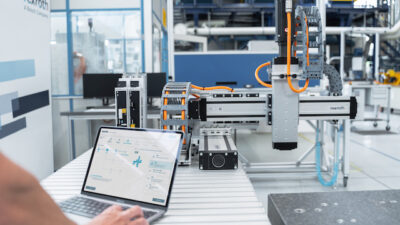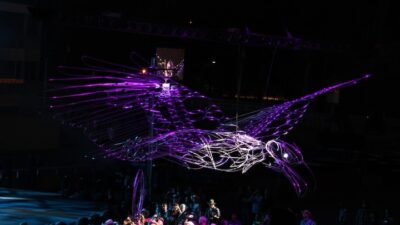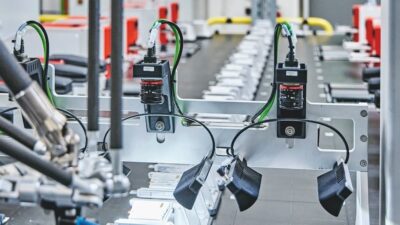A dozen application-specific lists, and more detailed information online, help you sort through controller choices no matter what type of system you're building or upgrading.
Like the cereal aisle in the grocery store, the number of controller vendors and individual controller models available can present a daunting choice. Faced with so many options, many engineers simply go with what they or their predecessor have used before. But that may not be the best choice for your application. So Control Engineering asked application engineers and other experts from a dozen controller vendors to offer some of their expertise regarding what application-specific controller features to look for. Here’s a taste of what they had to say, arranged by application type. Online, you’ll find expanded essays and links to customer case histories and whitepapers that provide more detailed instruction. You also can respond online and tell us about your application, or post a question to our application experts. Scroll down the home-page at www.controleng.com this month to find the link to the current issue, or visit the magazine archives there anytime.
Packaging Machine
Packaging machine
Packagingmachines range from all mechanical (GEN I) to hybrid servo andmechanical (GEN II) to all-electric driven machines with full servodesigns (GEN III). GEN III machines are designed from the ground uparound what servos and controls can do to electronically synchronizethe entire machine, without the need for a line shaft and complex fixedmechanical cams. GEN III machines are virtually all electrical, withsignificantly fewer mechanical parts and greater functionality, such asrunning multiple products and supporting automated changeover. Theall-electric system typically runs at higher speeds and is responsiblefor electronic synchronization, complex camming, and high speedregistration along with advanced high speed robotics capabilities.Therefore, it will require a faster controller (with a scan time of50–100 μS) and very fast acting I/O—or, more likely, a motion control
network to handle I/O update times. Memory of 1 MB or more may be
required to handle various packaging line product recipes. Choosing a
controller for a packaging machine also requires addressing additional
issues, including:
What is the application?
Foodand beverage packaging applications fall into a set of broadly-definedtypes and subcategories. Form, fill and seal machines, for instance,can be vertical or horizontal machines. Cartoners can be continuous orintermittent motion style machines. Each application and its variantshave certain requirements that will dictate what type of controller isselected, based on the amount of I/O functions, connectivity, andcomplexity of advanced capabilities.
What are connectivity considerations?
Connectivitycan be for remote I/O, between controllers, or up to a Level IIsupervisory or SCADA system. The decision on which network to use ispredicated on personal preferences, customer specifications,availability of components, and regional concerns. Controller tocontroller (C2C) communications can be accomplished through proprietarynetworks such as MelsecNet or DH+, or through open networks such asSERCOS II. Connection to SCADA usually requires Ethernet capability.Ethernet has emerged as a medium of choice for remote I/O and C2Ccommunications as well.
Is scalability important?
Scalabilityis the ability to move up or down a PLC product line to easily add orsubtract functionality. Some vendors have different software andhardware form factors for their lower- and higher-end PLCs; others havea unified line of software and hardware products. Both approaches haveadvantages. Bosch Rexroth is an example of a unified line: It can scalefrom a GEN I to a GEN III machine by adding motion and other advancedfunctionality without negating previous engineering efforts andhardware purchases.
What software and programming functionality is required?
Alow-end GEN I machine will probably only require ladder logic; a GENIII cartoner running at a high speed, using registration and robotics,will require advanced robotic function blocks and path plannercapabilities. For the latter, look for a controller vendor thatprovides templates and out-of-the-box functions, such as functions toaccomplish certain tasks such as temperature control or running arotary knife. They allow greater programmer freedom than templates.
Ted Thayer, automation systems product manager, Bosch Rexroth Electric Drives and Controls, www.boschrexroth-us.com
Automated guided vehicles
Automated guided vehicles
AGVs are often used to transport heavy loads or explore hazardous areas. The controller you choose should:
Be capable of running multiple PID loops ,for speed control as well as steering. Using digital counting, thecontroller could determine rotation rate or "turnover" of the AGV’swheels as it ascends a hill. The controller would then compare that tothe figures taken when the vehicle travels on flat terrain. Through PIDcontrol, as the controller sees the count drop, it knows that thevehicle must be slowing down, and then will send a command to"throttle-up" or accelerate the AGV.
Be flexible in terms of its I/O and data handling capabilities. Thecontroller/system chosen should be able to process signals frominfrared, radar, proximity, and other sensors used to detectobstructions or path debris. This lets the AGV be programmed forcollision avoidance.
Support wireless communications .A wireless controller eliminates the need to repeatedly physicallyconnect the vehicle for data acquisition, debugging, and controlprogram modifications. A wireless interface could also gatheroperational data (engine oil, air, and water temperature, batterycharge, etc.) from vehicle components via sensors. Most suchapplications operate over wireless Ethernet (wireless LAN or Wi-Fi),but use of wireless wide area networks (WWAN or cellular) is growing.
David Crump, marketing communications manager, Opto 22 , www.opto22.com
Pick-and-place robots
Pick-and-place robots
Atrend exists among machine builders—particularly within packaging andfood processing industries—to embed robotic pick-and-placefunctionality into their machine designs rather than integratestand-alone robots. A controller employing advanced mathematicalalgorithms is key to smoothly coordinating the robot’s motion. Alsoconsider:
Processor power. Acontroller that can run multiple robots as well as the other motion andlogic functions of a packaging machine in a single program on a singleprocessor is ideal. This eliminates the cost of a separate robotcontroller without resorting to multiple CPUs. In some cases, theentire control program can execute in the processor’s cache memory tomaximize program execution speed.
Tool center point functionality. Tool center point (TCP) represents a fundamental distinction betweenmachine and robotic motion. In machines, motions are defined as a setof trajectories for each servo axis. Compared to robots, only simplekinematics are available. In robots, motions are related to the TCP andnot to individual axes. Motions are defined by the target position andtype of movement of the robot. The required trajectories for each motormust be calculated.
Kinematics. The Schneider Electric robotic software library has a tool to performcomplex control calculations automatically. The engineer can programcartesian motion just as he or she would for a conventional machineinto an IEC 61131-3 conforming function block. Then a transformationfunction block performs all necessary kinematics, including trueinterpolation.
Additional features. A geometrical blending capability reduces cycle times by "blending" thepath to optimize speed and distance traveled to reach the target point.Since robots can develop some G forces and too much can overcome agripper’s holding force on a product, look for intelligent accelerationmonitoring.
Joe Krogman, project manager, Schneider Electric ELAU Packaging Solutions, www.elau.com
Gas production plant
Gas production plant
Controlof modern gas production plants is typically handled by a panel-basedoperation with the help of single-loop controllers, recorders,indicators, and annunciator boards. Processes typically run 24/7, withfew or one control room and 400 to 2,000 I/O points, depending onthroughput and degree of automation. Precise analog control is neededto meet processing conditions, especially during start-up.
Whenselecting a distributed control system (DCS) for a gas productionplant, the priorities are safe operation and high availability,followed by ease of use in maintaining the system. A scalable system iskey, as future expansion is certain. Also, the DCS must be ready towork right out of the box. Gas plants also deal with three mainenvironmental conditions that can affect equipment choice: explosiveatmospheres, caustic conditions, and toxic gasses. Also consider:
Migration. Switching from an existing control system to a new one must be donewith minimal or no downtime. Communication among components should workseamlessly and allow for expansion even during production. Integrateddevelopment tools reduce engineering configuration time. Upgrading frompneumatic and single loop controllers requires a system using IEC61131-3 control programming standards.
Redundancy must be handled internal to the system, not through a voting unit or anexternal application, so a local operator can bring a failed systemback online quickly, without complex steps. The running system shouldcheck the hardware, load firmware, load the application, and sync thesystem when the failed CPU is replaced.
Interfaces. It is helpful to recreate existing panel graphics as part of new HMIdisplays. Process alarms should immediately navigate to the faceplatethat controls the tag.
Gero Lustig, Freelance 800F DCS business development, ABB Inc. www.abb.us/ProductGuide
Pump system
Pump system
Forpumping systems, use alternating relays as level controllers. Typicallyused in applications where the optimization of load usage is required,alternating relays equalize the run time of two loads through the useof control switches (float switch, manual switch, timing relay,pressure switch, etc.). Each time the initiating switch is opened, theoutput relay contacts change state, thereby alternating the two loads.Also, in the case of excess load requirements, an alternating relay canbe used to add capacity. The control of multiple pumps also can behandled through use of alternating relays. Typical control methodsinclude:
Simple alternator. This allows for the alternation of pumps to equalize wear. In a duplexor two-pump example, the first pump starts and runs; when the firstpump stops, a second pump is selected for the next run-cycle.Alternators are available for duplex (two-pump), triplex (three-pump),and quadruplex (four-pump) operation.
Lead-lag operation. This method involves the selection of a primary or "lead" pump, and asecondary or "lag" pump to accommodate additional capacity. The pumpsalternate; if additional capacity is not needed, the lag pump does notrun but alternating action still occurs.
Designedfor use in multiple load, triplexor, and quadruplexor applications,alternating relays can perform both simple alternator and lead-lagoperations. Control inputs can consist of floats or switches. Once themode(s) of operation, control voltage, and the number of pumps areunderstood, selecting the appropriate controller is a matter ofcomparing the requirements to available pump controllers.
David Bredhold, MS, application engineer, Eaton Corp., https://budurl.com/EatonPumpPanels
New production line
New production line
Selectinga controller for discrete factory automation traditionally starts withan I/O list of signal types and specifications. This list includesvoltage, current, and any specialty interfaces for safety, motioncontrol, high-speed counting, temperature or smart devices. Next comeother system attributes, including distributed networked I/O modules toreduce wiring and conduit, support for built-in software functionalityto reduce programming time, and business system connectivity forproduction reporting.
Typical factorytransfer lines and related production applications benefit fromchoosing an automation controller family that has a common engineeringsoftware framework that can accommodate system expansion over time.Siemens Simatic S7 product line, for example, includes a variety ofcontrollers for small, large, PC-based, distributed, embedded, andmachine-mount use (no enclosure required), and are all programmed withStep 7 engineering software. With such a controller, production lineequipment that remains physically unchanged for 10+ years can beupgraded to increase efficiency and add specialty functions, such asintegrated safety, within the controller.
Thistype of foresight into controller selection can be a competitiveadvantage, as demonstrated by the new production line put in at theSouthland Tube steel mill. The company chose a Siemens Simatic S7-400controller with distributed ET200 I/O on Profibus and Profinetcommunications connecting networked drives and motor starters. Thiscontroller architecture (Siemens Totally Integrated Automation), andWinCC visualization software for the SCADA control room, savedsignificant time and money during engineering and startup.
Thecontroller choice provided the processing power and device networkconnectivity to automate more than 30 drives and 300 motors. With allcontroller, I/O, and smart devices sharing the same software framework,Southland gained tools for configuration, diagnostics, andcommissioning. Such an application could not be accomplished bycombining many smaller stand-alone controllers.
Paul Ruland, Automation & Motion Division, Siemens Energy & Automation, Inc., www.sea.siemens.com
To learn more about Southland tube, read "New production line in record time."
CNC machine tool
CNC machine tool
Engineersconcerned with finding that controller "sweet spot" are trying tobalance performance with budget. Also, the right controller isn’t goingto stay right forever, so they need flexibility to move as applicationsevolve and new markets are entered. Kays Engineering chose CX9010 andCX1010 Embedded PCs from Beckhoff Automation to control its CNC machinetools, partially so Kays can migrate to more powerful controllers asdrilling technology evolves. Other considerations:
Processors & networks. Beckhoff’s CX PAC line, for example, starts at the Intel IXP420 XScale266 MHz processor level and allows continuous upward migration to IntelPentium M CPU, 1.8 GHz processors. As technology advances, thecontroller vendor also should incorporate new technology, such asenergy-saving Intel Atom processors. The processor also must be capableof handling the specific program software. Kays’ EtherCAT-based motionsystem provides optimum speed and position control of the machinetool’s axis slide.
Software. Thesoftware should support variants for machine tools, including NC PTP,NC I, and CNC editions. It also should include time-saving features forfrequently used functions such as code libraries, 3D interpolation,flying saw, camming, electronic gearing. Whatever the application, italso should help optimize programming, add functionality, saveengineering time, and help eliminate expensive mechanical andelectronic components.
Corey McAtee, product manager, Beckhoff Automation, www.beckhoffautomation.com
For more on Kays Engineering’s application, read "Embedded PCs Keep Drilling Machines on Budget."
Simple batch applications
Simple batch applications
Forvery simple batch applications, just about any controller will do andjust about any programming language is applicable—if the process neverchanges. A batch process, however, rarely remains static, and that’sthe key factor engineers should keep in mind when selecting acontroller.
In many batch processes,there are benefits to executing unit procedures directly in acontroller: reduced complexity, or improved availability or speed ofexecution. Select a controller that: 1) allows for increased batchexecution availability by executing a complete single-unit procedure ina redundant controller; 2) increases throughput by reducing batchexecution times and latency between application levels; and 3) offersimproved operator usability through display integration and interactiveinstructions. A process controller (or two) should be used, however, ifthe process expands and execution directly in the controller is notpossible due to the size of the operation. Peer-to-peer communicationbetween controllers allows building a larger process as needed.
Selecta control environment that hosts all four levels of the ISA88procedural model—procedure, unit procedure, operation, and phase—andsupports online modifications for all elements of the batch automationsolution. This means all four levels are authored and maintained in thesame tool so users can change one element of logic, download it, andtrack a version change for just that modified element. There’s no needto increment the version of the entire batch automation strategy.
Joe Bastone, Honeywell Process Solutions, www.honeywell.com/sites/acs
Embedded system
Embedded system
WhenFedEx Express contracted with Ventura Aerospace to build an intelligentcontrol system for in-flight fire monitoring and suppression, theyneeded to find a controller that was reliable, compact and flexibleenough for the application. They chose an NI Single-Board RIO — 9612for the brain of its fire control hub and 14 fire control unitsdistributed along each plane. The sbRIO-9612 included a 400 MHz PowerPCprocessor running a real-time operating system and a 2M gate XilinxSpartan 3 FPGA, coupled with 110 high-speed digital I/O lines and 16differential channels of analog input on a single board.
Theboard-level form factor was ideal because it let the company design acustom daughtercard mounted directly onto it, which added additionalsignal conditioning and connectivity to the MIL-rated connectorsnecessary for aircraft use. Designers of similar embedded systems alsomight choose the controller for the following:
Its less than 8.5 in. × 6 in. form factor does not require a fan or active cooling.
Itincludes both a real-time processor and onboard FPGA. The real-timeprocessor deterministically closes PID and other control loops whileautomatically balancing non-deterministic operations, such as Ethernetcommunication and file I/O. In parallel, the FPGA is used for customanalog and digital data acquisition and generation, in-line signalprocessing, and high-speed control. Programming is quick and easybecause LabVIEW is used for both programmable targets on the controller.
Itincludes options for high-speed analog and digital I/O (including 24VDI and DO), and supports over 80 plug-in I/O modules from NI and others.
Matt Spexarth, product marketing engineer, National Instruments www.ni.com/embedded
CNC machine retrofit
CNC machine retrofit
ACNC retrofit typically upgrades the CNC, the servo motors and drives,the spindle motor and drives, and a portion of the associated wiringand related electromechanical components. Unlike rebuilding andremanufacturing, a CNC retrofit does not include any major repairs tothe machine mechanics. Consider the following:
Error-proofing with custom macros
Theflexibility required for high-mix manufacturing implies a level ofprogrammability and, in fact, most CNCs incorporate some form ofparametric programming. GE Fanuc calls this part programming featureCustom Macro B, and it is available on all current and many legacycontrols.
Machine tool probing
Manufacturersget concerned about the time required for machine tool probe cycles,but the truth is that they are faster and more accurate than anoperator can be. They are consistent, eliminating operator measurementand data-entry time variation for a predictable task time. Add amachine tool probe system during a retrofit, or at least choose acontroller that makes the machine probe-ready.
Expanded part program memory
CNCpart program memory space has traditionally been very limited, eitherby technology or cost. GE Fanuc controllers support a data server,which combines the features of Ethernet communications and a very largepart-program storage location. The approved, high-speed flash memorycard for the data server can handle up to 1 GB of part programs.
Maintenance training
Machinecrashes related to setup errors remain a source of downtime, soautomate and error-proof as much of the process as possible. Controllerdiagnostic tools let operators troubleshoot and recover quickly when aproblem occurs; for example, diagnostics pages can provide a single,convenient location to monitor the status of the CNC, servo, andspindle systems.
Remote diagnostics, back up & restore
AnEthernet port provides maintenance and industrial engineers with amethod to remotely diagnose problems using a tool such as GE Fanuc’sCNC Screen Display Function. Some CNC controllers incorporate automaticbackup of files to flash memory, for one level of data security; GEFanuc also offers Proficy Change Management for CNC.
Mark Brownhill, GE Fanuc CNC, www.gefanuc.com/products/family/cnc
For the full whitepaper from GE on factors to consider when doing a CNC retrofit, visit the Control Engineering Resource Center to read Machine tool remanufacturing: The Retrofit Advantage
www.controleng.com



